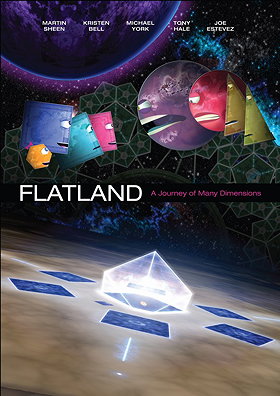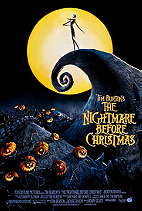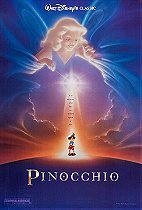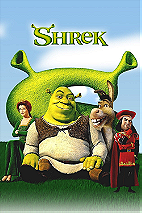Description:
The year 2007 brought a historic cinematic event of fabulous height and spiritual depth, one which made it to neither theater nor rental, but can be purchased directly on DVD. Yes, I need to tell you about not one but two fine animated versions of the classic Victorian novella Flatland, a genre-defying political religious sci-fi adventure that remains the greatest selling math book of all time, as well as one of the funniest weirdest most mind-stretching stories that most people will remember their entire lives.
People who know Flatland know that I’m not exaggerating. This cultural event of the mind and spirit continues
The year 2007 brought a historic cinematic event of fabulous height and spiritual depth, one which made it to neither theater nor rental, but can be purchased directly on DVD. Yes, I need to tell you about not one but two fine animated versions of the classic Victorian novella Flatland, a genre-defying political religious sci-fi adventure that remains the greatest selling math book of all time, as well as one of the funniest weirdest most mind-stretching stories that most people will remember their entire lives.
People who know Flatland know that I’m not exaggerating. This cultural event of the mind and spirit continues to be celebrated in the most intriguing places. There are role-playing games. Top writers and thinkers write sequels, schools and colleges teach it. Carl Sagan used it on "Cosmos" (1980), and there was a Flatland sequence in the New Age philosophy flick "What the Bleep Do We Know!?" (2004) Flatland seems destined to be an cherished part of the ever-expanding future of humanity. To have two of the best movie versions ever made both released in 2007 is surely a sign from and for that future (previous minor shorts were hand-drawn decades ago).
Why two versions? There is a strange acknowledged phenomenon in cinema that I call movie twinning. Inexplicably, to promoters’ chagrin, films often come in complementary pairs. Call it dumb luck, the zeitgeist, synchronicity, or deeper guidance, but examples abound. Remember 1998? That was the year of two big flicks about animated bugs, and two blockbusters of comets hitting the Earth. Audiences get confused, markets get diluted. Or energized, if handled right.
So with two Flatlands to stack up, let’s get it straight. Both are computer animated (they have to be, what with talking lines, squares, circles, and spheres, all on a budget). Both are updated from Victorian settings, with reasonable results (the feature’s Sphere runs a scandalized corporation, while the short has alien artifacts circa area 51).
"Flatland: The Movie" (2007) is a half-hour educational treat for all ages, a looser adaptation with gorgeous visuals and star voices. "Flatland: The Film" (2007) is a ninety minute indie feature which preserves the biting social satire of the original story with ideas and abstract violence (bleeding polygons) not appropriate for little kids (teens will be fine). The short movie is basically happy, mysterious, inspiring to the sciences, and will be popular among teachers. The feature length film touches on current events, including allusions to the Iraq war and anti-gay prejudice, to conclude apocalyptically (the book just ends with the protagonist in prison). Most adults will want to see both Flatland versions, sooner or later.
So what’s all the fuss about, what is a Flatland anyway? Flatland is a remarkable timeless metaphor for the expansion of human consciousness into new dimensions, and the societies which try to hold back those individuals who would lead us into the future. We see ourselves in the whimsical struggle of a two-dimensional square trying to comprehend the world from which has come a millennial messiah, who is a three-dimensional sphere. The planar universe of the square is called Flatland, and is ruled by a social order of increasing sides, culminating in the priests and kings who are approaching circle-hood. The square makes his evolutionary leap to the next dimension by comparing himself in turn to the limited worlds of a point and a line, and then departing with the sphere to visit his city. Unfortunately, square’s enlightenment is so complete that not only does he return as a pariah of his own society, even his godly sphere savior leaves offended at the suggestion that still higher gods and dimensions must exist above him.
Surprisingly, the analogies of the fully-titled book "Flatland: A Romance of Many Dimensions" go as deep down the rabbit hole as you care to explore. In 1884 when it was published by Edwin Abbott Abbott (his parents were cousins, so he got the same last name twice) the celebrities to roast included millennial Christians, Victorian chauvinists (Flatland women are piercing lines with frightening properties), Euclidean thinkers (mathematics was overturning to make way for Einstein), and narrow-minded leaders everywhere. The late 19th century saw the rapid spread of spiritualism from the United States to England, so theologians as well as lay people were straining for new images to explain where spirits and angels might be coming from. A fourth dimension was hotly debated until the public was ripe for the Flatland analogy, though nothing quite foreshadowed it like one precedent article which Abbott probably read. In 1880 geometer Charles Howard Hinton wrote "What is the Fourth Dimension?" about similar creatures. In 1907 Hinton wrote the first Flatland sequel, titled "An Episode on Flatland: Or How a Plain Folk Discovered the Third Dimension".
The relevance of Flatland remains astounding to this day. Much of the charm comes from logical descriptions of life in two-dimensions, including flat mechanical systems like plumbing, favorites of Victorian armchair theorists that are now finding application in nanotechnology. The stinging social satire, worthy of Jonathan Swift or Rabelais, includes a fascinating system of hierarchical white shape recognition and the threat of a colored revolution. Even our most modern intersection of spirituality and science, in which mathematicians increasingly advise us to believe in a 11 dimensional universe of universes (the multiverse), is largely seeded by brilliant people who were deeply affected by Flatland in high school or college. While string theory and m-theory may never be proven directly, the recent discovery of so-called dark matter, incredibly constituting an invisible 90% of our universe, may be evidence of the next dimensional universe interpenetrating our own. Imagine that! (GlobalIntelligencer.com review)
Visit film website: [Link removed - login to see]
... (more)
(less)
My tags:
 Add tags
Add tags
 2 comments
2 comments 2 comments
2 comments Login
Login





















 History of art in cinema
History of art in cinema









